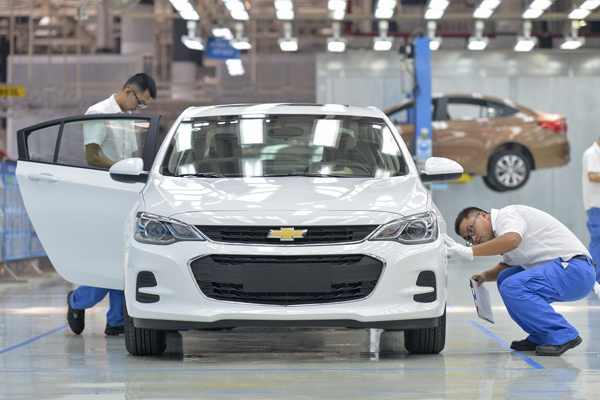 |
|
Engineers check a Chevrolet car at a General Motors production line in Wuhan, Hubei province. [Photo by Shen Shen/For China Daily] |
General Motors Co generates $1 billion in pretax profit a month. Yet the stock market seems unimpressed, assigning the company a market value of just $50 billion.
So why are GM shares so cheap? It's one of the more vexing questions Dan Ammann, the company's president, faces every day. The Detroit automaker posted record profits last year, will be close to that level this year and is putting the pieces in place for a run at more growth in 2017, Ammann said in an interview at Bloomberg News headquarters in New York. GM has a wave of new, high-margin sport utility vehicles coming to market in the next few years, and the company believes that, even with the rapid growth of ridesharing services, car sales will continue to be steady and profitable.
"The core of where we make money will be sustained for a long time to come," he said. "We are delivering real results and we see opportunity to grow."
At the same time, the tech giants that have been casting a shadow over GM's future with plans of high-tech driverless cars suddenly look less threatening. Alphabet Inc's Google has hinted it may not want to build a car after all, and Apple Inc's plans remain unclear. Even Tesla Motors Inc has lost the love of some investors, as a proposed merger with Solar-City Corp looks problematic.
Still, investors aren't listening to Ammann's message. GM stock is down about 6 percent this year to $32.17 a share, below the 2010 initial public offering price of $33 and way off its Dec 17, 2013, high of $41.53. That's despite record net income of $9.7 billion last year and a consensus forecast for $9.2 billion this year.
Ammann and GM Chief Executive Officer Mary Barra have had to wrestle with investor perceptions that the traditional car market has peaked. It hasn't helped that crosstown rival Ford Motor Co has reined in its own earnings forecast, pulling GM shares down as its stock falters.
GM is being punished in part because it has been late to develop new crossover SUVs like Honda's CR-V and BMW's X3. But all that's about to change, Ammann said. GM has a handful of SUVs coming out in the next few years, and a redesigned Chevrolet Equinox will go on sale in the first quarter of 2017 after seven years without a major update.
Meanwhile, GM's luxury brand continues to struggle. Cadillac has just two SUV models, the hulking Escalade and the more nimble XT5, compared with at least four from rivals including Daimler AG's Mercedes-Benz and BMW. Ammann said Cadillac will add several more in the next three years.
Raising prices
Even without those new models, GM has been raising prices to an average of $35,000 a car, $1,000 higher than last year and $5,000 over the industry average.
Perhaps GM's biggest perception problem with Wall Street is that it remains an old fashioned, out-of-style Detroit producer of mass vehicles, while investors see true innovation in the industry coming from the likes of Apple, Uber Technologies Inc and Google, all of which want to master self-driving models and ride-hailing apps that could replace individual car ownership.
Ammann sees those technological advances as an opportunity rather than a threat. Cars now travel an average of about 15,000 miles a year. A vehicle in a ride-sharing service could go as many as 80,000 and would need to be replaced-or perhaps refurbished in some fashion-far more often, he said.
New revenue source
That's why GM has invested in Lyft Inc and is renting cars to Lyft drivers-especially those vehicles that customers have leased and brought back to dealers. This provides GM with another new source of revenue and keeps low-mileage models from going to the used-car market and undercutting its new-car prices.
Still, ride sharing could prove to be the weak link in GM's growth strategy. Lyft is expanding but is far outflanked by market leader Uber, newly flush with an investment from Chinese ride-share company Didi Chuxing.
Ammann wouldn't say whether GM would work with Uber by providing it with leased vehicles, as Toyota Motor Corp has agreed to do, or by jointly developing a fleet of self-driving cars. Right now, he said, the company is working on this with Lyft.
"The ride-sharing business is in its early days, and we're in the early days of the shift from ownership to sharing."
There are some signs GM is getting its message across to investors. Nine of the 23 analysts covering the company have some version of a buy rating on its stock and just one has a sell rating, according to data compiled by Bloomberg.
Transformational tech
The shares saw a 2.4 percent bounce last month after a recommendation from Morgan Stanley analyst Adam Jonas, long a bull for Tesla and considerably dour on Detroit's venerable automakers. He reasoned GM's core business will generate stable profits for the next two years and the transformational technologies from Silicon Valley are further off than people realize. His recommendation for GM came several months after he downgraded Tesla.
In discussions with investors, however, he found "great apathy and skepticism" toward the company; "sentiment appears even lower than we had previously thought," he said in a note 10 days after his recommendation. The shares fell 1.3 percent that day.
